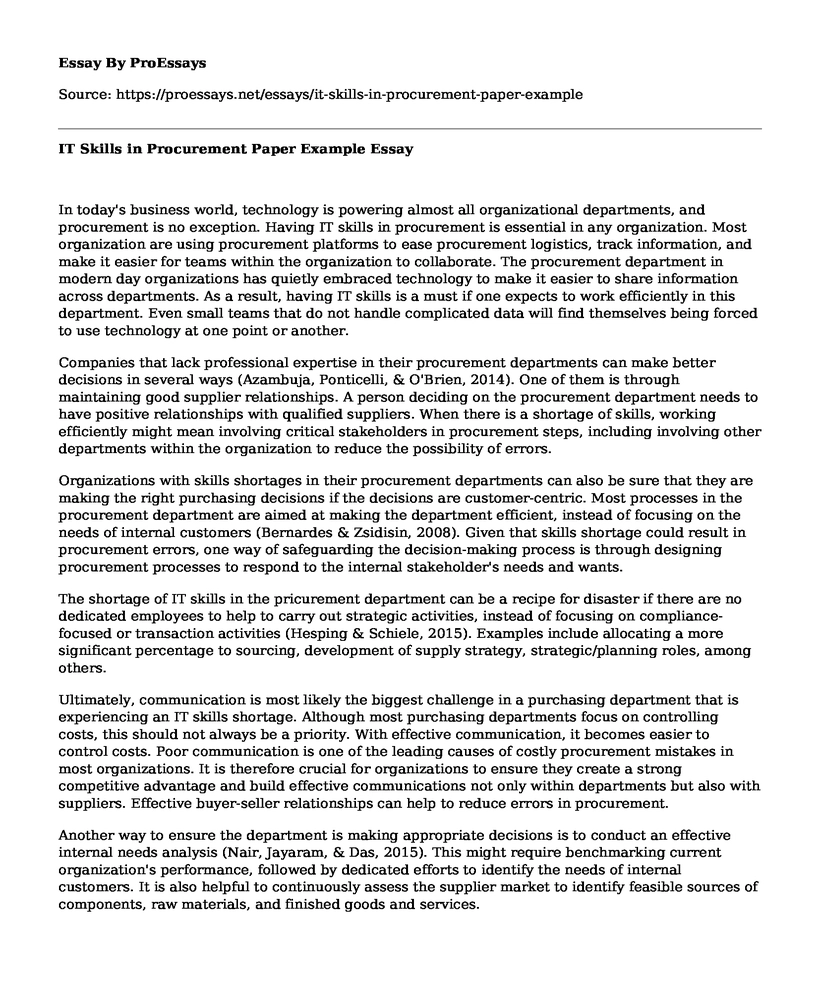In today's business world, technology is powering almost all organizational departments, and procurement is no exception. Having IT skills in procurement is essential in any organization. Most organization are using procurement platforms to ease procurement logistics, track information, and make it easier for teams within the organization to collaborate. The procurement department in modern day organizations has quietly embraced technology to make it easier to share information across departments. As a result, having IT skills is a must if one expects to work efficiently in this department. Even small teams that do not handle complicated data will find themselves being forced to use technology at one point or another.
Companies that lack professional expertise in their procurement departments can make better decisions in several ways (Azambuja, Ponticelli, & O'Brien, 2014). One of them is through maintaining good supplier relationships. A person deciding on the procurement department needs to have positive relationships with qualified suppliers. When there is a shortage of skills, working efficiently might mean involving critical stakeholders in procurement steps, including involving other departments within the organization to reduce the possibility of errors.
Organizations with skills shortages in their procurement departments can also be sure that they are making the right purchasing decisions if the decisions are customer-centric. Most processes in the procurement department are aimed at making the department efficient, instead of focusing on the needs of internal customers (Bernardes & Zsidisin, 2008). Given that skills shortage could result in procurement errors, one way of safeguarding the decision-making process is through designing procurement processes to respond to the internal stakeholder's needs and wants.
The shortage of IT skills in the pricurement department can be a recipe for disaster if there are no dedicated employees to help to carry out strategic activities, instead of focusing on compliance-focused or transaction activities (Hesping & Schiele, 2015). Examples include allocating a more significant percentage to sourcing, development of supply strategy, strategic/planning roles, among others.
Ultimately, communication is most likely the biggest challenge in a purchasing department that is experiencing an IT skills shortage. Although most purchasing departments focus on controlling costs, this should not always be a priority. With effective communication, it becomes easier to control costs. Poor communication is one of the leading causes of costly procurement mistakes in most organizations. It is therefore crucial for organizations to ensure they create a strong competitive advantage and build effective communications not only within departments but also with suppliers. Effective buyer-seller relationships can help to reduce errors in procurement.
Another way to ensure the department is making appropriate decisions is to conduct an effective internal needs analysis (Nair, Jayaram, & Das, 2015). This might require benchmarking current organization's performance, followed by dedicated efforts to identify the needs of internal customers. It is also helpful to continuously assess the supplier market to identify feasible sources of components, raw materials, and finished goods and services.
The department might also need to continuously collect and update supplier information. A good strategy begins with a careful selection of suppliers, where the department ensures that all suppliers meet the organization's selection criteria to eliminate losses. The performance and reputation of suppliers need to be evaluated.
An organization whose procurement department lacks IT skills might also need to develop a robust outsourcing strategy based on the information collected from the previous steps. Examples of outsourcing strategies include direct purchase, where the purchasing department sends requests for proposals or requests for quotes to pre-selected suppliers. Ultimately, developing the best plan ultimately depends on the competitive nature of the marketplace of suppliers.
References
Azambuja, M. M., Ponticelli, S., & O'Brien, W. J. (2014). Strategic Procurement Practices for the Industrial Supply Chain. Journal of Construction Engineering and Management, 140(7), 06014005. doi:10.1061/(asce)co.1943-7862.0000851
Bernardes, E. S., & Zsidisin, G. A. (2008). An examination of strategic supply management benefits and performance implications. Journal of Purchasing and Supply Management, 14(4), 209-219. doi:10.1016/j.pursup.2008.06.004
Hesping, F. H., & Schiele, H. (2015). Purchasing strategy development: A multi-level review. Journal of Purchasing and Supply Management, 21(2), 138-150. doi:10.1016/j.pursup.2014.12.005
Nair, A., Jayaram, J., & Das, A. (2015). Strategic purchasing participation, supplier selection, supplier evaluation and purchasing performance. International Journal of Production Research, 53(20), 6263-6278. doi:10.1080/00207543.2015.1047983
Cite this page
IT Skills in Procurement Paper Example. (2022, Sep 05). Retrieved from https://proessays.net/essays/it-skills-in-procurement-paper-example
If you are the original author of this essay and no longer wish to have it published on the ProEssays website, please click below to request its removal:
- Course Work on Quality Management and Six Sigma
- Power and the Image of Nursing Essay Example
- Essay on Healthcare Risk Mgt: Ensuring Patient Safety & Meeting Regulations
- Essay Example on Leadership: Striking a Balance of Inclusivity in the Workplace
- Essay Example on Creating Positive Educ. Culture: Involving All Stakeholders
- Non-Profits vs For-Profits: How Different Are They? - Free Paper
- Mental and Physical Tasks - Report Example







